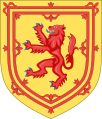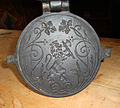Coat of arms of Norway
| Royal Version | |
|---|---|
 | |
| Armiger | King Harald V of Norway |
| Adopted | 1905 (present design) 1280 or earlier (origin) |
| Shield | Gules, a lion rampant Or, crowned and bearing an axe Or with blade Argent,the shield on a mantle Purple lined Ermine, crowned Or |
| Motto | Alt for Norge |
| Order(s) | Order of St. Olav |
| State Version | |
|---|---|
 | |
| Armiger | King Harald V of Norway |
| Adopted | 1992 (present design) 1280 or earlier (origin) |
| Shield | Gules, a lion rampant Or, crowned and bearing an axe Or with blade Argent etc. |
The Coat of arms of Norway (Norwegian Bokmål: Norges riksvåpen; Nynorsk: Noregs riksvåpen) is blazoned Gules, a lion rampant Or, crowned Or, holding an axe Or with a blade argent, meaning that it is a standing golden lion bearing a golden crown and holding a golden axe with a silver blade, everything on a red background.
The coat of arms is used by the King (including the King's Council), the Parliament, and the Supreme Court, which are the three powers according to the Constitution. It is also used by several national, regional, and local authorities that are subordinate to the aforementioned, for example the County Governors and both the district courts and the courts of appeal. Since 1905, two parallel versions exist: the original, more complex one used by the King and the simpler one used by the State.
In addition, there are former and existing lands (e.g. the Earldom of Iceland and the Orkneys), cities (e.g. Kristiansand), organisations (e.g. the Museum of Cultural History), companies (e.g. Adresseavisen), and families (e.g. the Counts of Gyldenløve and Gudbrand Gregersen) who have been granted the right to bear the coat of arms or derivations of this. Unless officially granted, it is illegal to use the coat of arms.
The coat of arms—originally a golden lion on a red shield—was adopted before or during the early part of the 13th century. In the late part of the same century, a silver axe was added, symbolising Olaf II as the Eternal King of Norway. In continuous use since then, the coat of arms is one of the oldest state coats of arms in the world. Following changing historical epochs, fashions and styles, the coat of arms has appeared in several rather different designs. The lion has gone from fit to fat and then back to fit. For many centuries, the axe had a long shape that made it look more like a halberd.
The lion, which in Norway is commonly known as The Norwegian Lion (Den norske løve etc.), has been a popular and embraced symbol for centuries. This popularity is, not least, visible in older folk art.
Key
In this article, the complex coat of arms of Norway is called the Royal Coat of Arms, whilst the simple variant is called the State Coat of Arms.
Royal Coat of Arms
General information
The Royal Coat of Arms is used by the King and Queen, by the Royal House, and by the Royal Court. The lion with the axe only appears in the Royal Standard. The Royal Coat of Arms had a design by Eilif Peterssen made in 1905, in which the design of the lion is somewhat more naturalistic than in the State Coat of Arms. Today the design is a little changed, especially the crown with the demi-lion omitted.[1]
Blazon
The official blazon is:
- Ei upprett gull-løve på raud grunn med gullkrone på hovudet og gullskjeft sylvøks i framlabbane.
In English:
- Gules, a lion rampant or, crowned or and bearing an axe with blade argent.
Crown and mantle purple lined ermine
In the coat of arms of the realm a heraldic, royal crown is placed directly on top of the shield. In the Royal Coat of Arms, the shield is on a mantle purple lined ermine with a royal crown on top. Three sides of the shield are surrounded by the collar of the Royal Order of St. Olaf.
Personal royal seals
In their personal royal seals, Haakon VII (r. 1905–1957) and King Olav V (r. 1957–1991) had a coat of arms with helmet and as crest a demi-lion crowned and with the axe. This crest appeared during the reign of King Haakon V.
Coats of arms of the King and the Royal Family

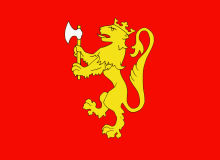

The following coats of arms are displayed with the collar of the Order of St. Olaf. However, not all Princes and Princesses are Grand Cross holders or, for that sake, members of this order at all, wherefore their respective coats of arms do not include this achievement.
| Coat of arms | Bearer | Description |
|---|---|---|
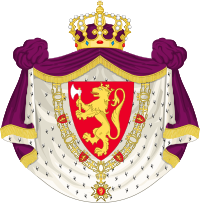
|
The King | |

|
The Queen | |

|
The Crown Prince The Hereditary Princess |
|

|
The Crown Princess Princes and Princesses |
Crowns of the King and the Royal Family



The following images are digital representations of the royal crowns, i.e. the physical crowns that are located in Trondheim. The images below are drawn based on how the physical crowns look. Images of the heraldic crowns, on the other hand, are drawn based on a blazon. Whilst there are big visual differences between the physical crowns and the heraldic crowns, technical differences are rather small. Note in this regard that whilst the King's physical crown has solely a cross on the top, the King's heraldic crown is equipped with the Norwegian Lion behind the mentioned cross.
| Crown | Bearer | Description |
|---|---|---|

|
The King | This is a representation of the physical crown of the King. |

|
The Queen | This is a representation of the physical crown of the Queen. It is heraldically correct and complete and may as such be used in the Queen's coat of arms. |

|
The Crown Prince The Hereditary Princess |
This is a representation of the physical crown of the Crown Prince. It is heraldically correct and complete and may as such be used in the Crown Prince's coat of arms. |

|
The Crown Princess Princes and Princesses |
This is a theoretical representation of the crown of a Prince. There is no physical crown for princes of Norway. It is heraldically correct and complete and may as such be used in a Prince's coat of arms. |
Royal Coat of Arms – history




Golden lion
Among the state coats of arms that are still in use today, the Coat of Arms of Norway is among the oldest in Europe and even world-wide. It is known since the early 13th century, when it served as the coat of arms of the kings of the Sverre dynasty. It is told that Sverre, who was King between 1184 and 1202, had a lion in his coat of arms. This coat of arms appears in 1225, when it was used by Earl Skule Bårdsson, who had relations to the royal family. A coat of arms with a lion was also used by Haakon the Young Haakonson, who was King between 1240 and 1257. This was in 1250. Haakon the Young's father, King Haakon the Old Haakonson, had a lion in his seal, too.
Snorre Sturlason claims that a golden lion on a red background was used already in 1103 by King Magnus III, the son of King Olav III. In 1894, historian Gustav Storm concluded that this is ahistorical. Storm explained that the claimed lion in King Magnus's coat of arms is unknown both in the older Saga literature and in other contemporary sources. It is possible that Snorre, who wrote under the instruction of the King, attributed King Sverre's coat of arms to earlier Kings of Norway.
It has been suggested but remains unconfirmed that Norway's coat of arms were an inverted version of or at least inspired by Scotland's. In the High Medieval Ages, there was extensive political and social contact between the two kingdoms, and considerable parts of the British Isles were either directly or indirectly a part of Norway. At least one coat of arms in Norway was deliberately derived from Scotland's coat of arms, possibly as a gift of honour from the Scottish King, namely the coat of arms of Baron Audun Hugleiksson. Otherwise, King Henry II of England (r. 1154–1189), a contemporary of King Sverre of Norway (r. 1184–1202), had in his coat of arms a golden lion on a red background. Despite all theories, the exact origin of the coat of arms is impossible to decide.
-
Coat of arms of England under Henry II.
| Coat of arms | Bearer | Description |
|---|---|---|

|
Earl Skule | Used in 1225. |

|
King Haakon the Old | Seal of 1247/1248, in which a small lion lies between the King's feet. |

|
King Haakon the Old | Reverse of the latter. |
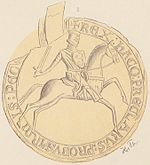
|
King Haakon the Young | Seal of 1250. |

|
King Eric II | Seal of 1298. Whilst the lion in the shield does not appear to bear an axe, the one on the caparison does. |
Introduced silver axe






Approximately in 1280, either King Magnus VI (dead in 1280) or the guardianship of his son Eric Magnuson let the lion be equipped with a crown of gold and in the foremost paws an axe of silver. The axe was a symbol of Saint Olaf, i.e. King Olaf II, and by inserting it into the coat of arms it was symbolised that the King was the rightful heir and descendant of the 'Eternal King of Norway' (Latin: Rex Perpetuus Norvegiae).
| Coat of arms | Bearer | Description |
|---|---|---|
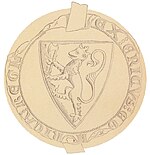
|
King Eric II | Seal of 1285. |
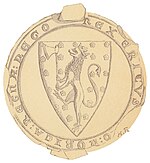
|
King Eric II | Seal of 1283 and 1285. This is a variant in which the shield has flowers. |
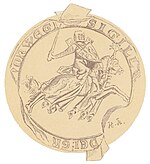
|
Duke Haakon Magnusson | Seal of between 1292 and 1298. |
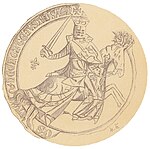
|
King Haakon V | Seal of between 1300 and 1302. |
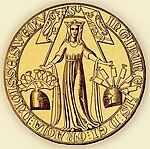
|
Duchess Ingeborg | Seal of 1318. |
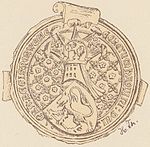
|
King Haakon VI | Seal on documents between 1358 and 1369. |

|
King Haakon VI | Seal on documents between 1358 and 1376. |
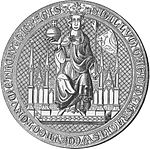
|
King Magnus VII (r. 1319–1343) | |
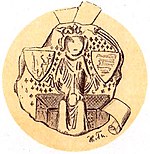
|
King Olaf IV | Seal of 1382 and 1384. |
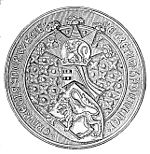
|
King Haakon V | |
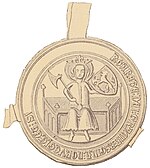
|
Queen Margaret | Her seal as Norway's sovereign. She holds both an Olaf axe and the Royal Coat of Arms—a powerful symbolism. |
Combinations until 1450



With the death of King Haakon V in 1319, the reign of the Sverre dynasty came to an end. The Throne and thus the Royal Coat of Arms was inherited by Magnus VII, who was a maternal grandson of Haakon V and who himself belonged patrilineally to the family known as the Bjälbo dynasty.
Subsequently, Norway remained in personal union with neighbouring countries. When acting as the ruler of one particular country, the sovereign would normally use the arms of that kingdom. When acting as sovereign of the united kingdoms, he would marshal the escutcheon by quartering. This was a tendency in Europe in general.
The first union kings placed the Royal Coat of Arms in the first quarter of the quartered coat of arms. At the beginning of the Kalmar Union, Norway as a hereditary kingdom was considered more important than Sweden and Denmark, which were still electoral kingdoms. Consequently, King Eric III of Pomerania placed his Norwegian Coat of Arms in an inescutcheon, superimposed on the coats of arms of his other realms. However, the Norwegian Coat of Arms would later be degraded, so that the Coat of arms of Denmark would occupy the first field, whilst Norway's was placed in the second.
| Coat of arms | Bearer | Description |
|---|---|---|

|
King Magnus VII (r. 1319–1343) | Coat of arms as presented in the Gelre Armorial. The royal coat of arms is combined with that of the Bjälbo dynasty, to which Magnus belonged patrilineally. It displays the original crest of the Norwegian coat of arms. |

|
King Eric III (r. 1389–1442) | |

|
King Christopher (r. 1442–1448) | Other versions: Modern interpretation of the coat of arms of King Christopher. |
Combinations from 1450 to 1814





In 1450, Count Christian of Oldenburg and of Delmenhorst became King of Norway. He was already King of Denmark since 1448, and in 1457, he became King of Sweden as well. Norway's coat of arms was placed in the lower dexter field and, when Sweden left the Kalmar Union in 1523, in the upper sinister field. The latter lasted until 1814.
Varying from time to time, the Kings between 1450 and 1814 bore the coats of arms of the following kingdoms, peoples, and lands:
- County of Oldenburg

- Kingdom of Denmark

- Kingdom of Sweden

- Kingdom of Norway
- Goths

- Wends (golden sea serpent)
- Duchy of Schleswig

- Duchy of Holstein

- Stormarn

- Dithmarschen

- Delmenhorst

- etc.
| Coat of arms | Bearer | Description |
|---|---|---|

|
King Christian I | |
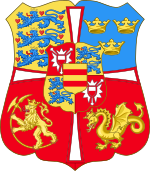
|
King Christian I King John King Christian II |
1460–1523. |
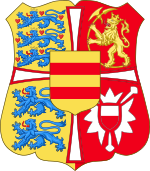
|
King Frederick I | |
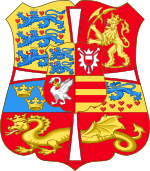
|
King Christian III | |
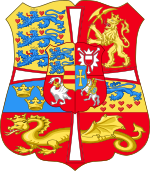
|
King Frederick II King Christian IV King Frederick III King Christian V |
|
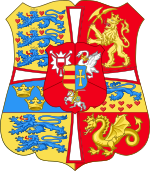
|
King Frederick IV King Christian VI King Frederick V King Christian VII King Frederick VI |
After his abdication in 1814, Frederick VI kept the coat of arms of Norway in his escutcheon until 1819. |
Combinations from 1814 to 1905





On 4 November 1814, the Norwegian Storting elected King Charles XIII of Sweden as King of Norway. This personal union with Sweden lasted until the dissolution of the union between Norway and Sweden in 1905.
Without legitimate heirs of the body, King Charles adopted the French marshall Bernadotte, Prince of Pontecorvo, who took the name Carl Johan.
The union arms introduced by King Charles XIII and Crown Prince Carl Johan were never used officially in Norway. Only the lion coat of arms of Norway appeared on coins and on seals of official documents signed by the King in his capacity as Norwegian king.
The union arms introduced by King Oscar I in 1844 was used by members of the royal family, by the common diplomatic service of both kingdoms, and on official documents concerning both countries. In Norway, the union arms was never used on coins or official documents.
In Sweden,Crown Princes and Princes bore the coat of arms belonging to his duchy. See Duchies in Sweden, but these titles and arms were never used in Norway.
| Coat of arms | Bearer | Description |
|---|---|---|

|
Crown Prince Carl Johan | 1814–1818. |
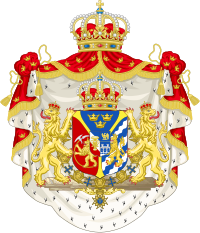
|
King Charles III John | 1818–1844. |
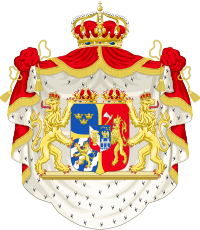
|
King Oscar I | 1844–1859. |

|
King Charles IV | 1859–1872. |

|
King Oscar II | 1872–1905. |
Independent versions since 1814


The halberd was officially discarded and the shorter axe reintroduced by Royal Order in Council 10 July 1844, when an authorised design was instituted for the first time. On 14 December 1905 the official design for royal and government arms was again changed, this time reverting to the medieval pattern, with a triangular escutcheon and a more upright heraldic lion. The painter Eilif Peterssen was responsible for the design.
| Coat of arms | Bearer | Description |
|---|---|---|
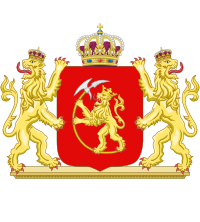
|
King Charles II (r. 1814–1818) King Charles III John (r. 1818–1844) |
All achievements are not displayed. |

|
King Oscar I (r. 1844–1859) King Charles IV (r. 1859–1872) King Oscar II (r. 1872–1905) |
Achievements are not displayed. |

|
King King Haakon VII (r. 1905–1957) King Olaf V (r. 1957–1991) King Harald V (r. 1991–) |
Royal Coat of Arms – other versions
Through centuries and following changing fashions in heraldry and arts, the Coat of Arms has appeared in several ways in the matter of design, shape, and so on. In the late Middle Ages, the axe handle gradually grew longer and came to resemble a halberd. The handle was usually curved in order to fit the shape of the escutcheon (or the changing union quarterings) preferred at the time, and also to match the shape of coins.
Official and semi-official versions
The Coat of Arms has also been used by subordinate state authorities and in semi-official contexts, such as on bank-notes.
-
Coat of arms of the Royal Army.
-
Badge of the Norwegian Police Service
-
Bordure variant used on coins, on financial documents etc. in the 19th century and in the early 20th century.
-
Design used by the Norwegian Telegraph Service, 1940s and 1950s.
-
1780 cavalry officer's sword.
-
Badge of the now dissolved Order of the Norwegian Lion.
-
Key of a chamberlain of the Norwegian court.
-
A menu of 1906.
Coins
-
C. 1285.
-
Minted by the Archbishop.
-
1544.
-
1628.
-
1632.
-
1648.
-
1649.
-
1660s.
-
1665.
-
1670.
-
1670.
-
1671.
-
1743.
-
1777, for East Indies trade.
-
1816.
Notes
-
Norwegian coat of arms on bank notes issued 1945–1976, designed by Arnstein Arneberg.
Stamps
-
The first Norwegian postage stamp from 1855.
Nasjonal Samling versions
On coins issued under German occupation during World War II, the royal cypher was replaced by the 1937 coat of arms without the royal crown. The Quisling regime continued to use the crowned coat of arms, although the emblem of Nasjonal Samling was used concurrently as an alternative state insignium. In 1943, the design of the lion was altered, and the royal crown was replaced with an open medieval leaf coronet. The Norwegian government in exile continued to use the coat of arms with the royal crown.
-
A representation of the Nasjonal Samling coat of arms version on a postage stamp of 1945.
-
A representation of the Nasjonal Samling coat of arms on the Medaljen for redningsdåd.
Private versions
For illustrational purposes, versions of the Coat of Arms have been created and/or used by private individuals and companies.
-
From an engraved image of Bergen in the Civitates Orbis Terrarum by Hieronymus Scholeus, published c. 1580.
-
From a portal erected in Trondheim during the royal visit in 1733. The axe handle has the curved shape used from c 1500 until 1844.
-
Cover of the 1900 book Norge i det nittende århundrede.
-
A decorative illustration by Karl Georg Jensen for Salmonsen's Encyclopedia, Copenhagen 1924.
Popular use
Unlike in Sweden and Denmark, where the respective coats of arms were mostly restricted for official use, the Norwegian Lion was for centuries well known to and even embraced by the people. It appears, among other places, in numerous works of folk art.
The Norwegian Lion was also popular during the romantic nationalism and as a symbol of Norwegian independence during the Swedish-Norwegian union and—without comparison—during Nazi Germany's occupation between 1940 and 1945.
-
Lid of a 18th-century beer tankard of birchwood.
-
Oven of 1668.
-
C. 1760.
-
C. 1780.
-
Late 1700s stick calendar (primstav)
-
19th century Krumkake iron with national coat of arms.
-
One of the two lions guarding the Parliament Builing.
-
Postcard of 1864.
-
Romantic nationalist art of 1905.
-
Centennial postcard of 1914.
-
Centennial postcard of 1914.
-
Centennial postcard of 1914. A rare and unofficial version with supporters — the Glücksburg supporter (a savage) and the English supporter (a lion, here with a three-point label).
Royal Coat of Arms – derivations
Derivations
Several coats of arms derivate from Norway's coat of arms. These include those of:
- The Earldom of Iceland, which was a part of Norway (shield in the Wijnbergen Armorial).
- The republic Jämtland, which was a tributary land of and later a part of Norway.
- The City of Kristiansund.
- The St. Olaf College in the United States of America.
- The medieval family Gyldenløve (lit. 'Golden Lion'), Norwegian nobles and royal descendants.
- The modern Counts of Gyldenløve, Dano-Norwegian nobles and royal descendants.
- The family Gregersen de Saág, Hungarian nobles from 1884 of Norwegian farmer ancestry.
-
A modern version of the coat of arms of the Earldom of Iceland in the Wijnbergen Armorial.
-
Coat of arms (seal) of the City of Kristiansand, established by King Christian VI.
-
Coat of arms of the Gyldenløve family.
-
Dano-Norwegian union coat of arms on a 1767 edition of today's newspaper Adresseavisen.
-
Coat of arms of Princess Anne of Denmark and of Norway as Queen of Scotland, of England, and of Ireland.
-
GB coat of arms of Prince George of Denmark and of Norway.
-
Logo of the Norwegian Museum of Cultural History.
-
House of Schleswig-Holstein-Sonderburg-Glücksburg.
-
Grand Duchy of Oldenburg.
-
Coat of arms of the Hungarian noble Gregersens (1884).
State Coat of Arms
General information


Nikolaj Bock

Andrew Butko
Royal decree of 20 May 1927 states:[3]
- Riksvåbenet må kun benyttes av Statens myndigheter i utøvelsen av deres offentlige virksomhet.
In English:
- The Coat of Arms of the Real may be used only by the State's authorities in the exercise of their official activity.
The Coat of Arms may be used by the Royal Court, by the Government and its Ministries, by the Parliament, by the Law Courts, and by some others. Matters of the Coat of Arms are treated by the Ministry of Foreign Affairs.
Blazon
The official blazon is:
- Ei upprett gull-løve på raud grunn med gullkrone på hovudet og gullskjeft sylvøks i framlabbane.
In English:
- Gules, a lion rampant Or, crowned and bearing an axe with blade argent.
Crest
The State Coat of Arms has no crest.
Crown
The State Coat of Arms is always to be displayed surmounted with the royal crown.
References
- ^ Website of the Royal House of Norway
- ^ Lewis, Suzanne: The art of Matthew Paris in the Chronica majora, p. 147. 1987. University of California. ISBN 9780520049819.
- ^ FOR 1927-05-20 nr 3729: Forskrift angående bruk av Rikets segl og Riksvåbenet. Lovdata lest 3. april 2013.
Literature
- P. Petersen: Historisk-heraldisk Fremstilling af Kongeriget Norges Vaaben, og Sammes Afbildning i Bannere, Flag, Mynter og Sigiller, Christiania 1836
- Gustav Storm: Norges gamle Vaaben, Farver og Flag, Kristiania 1894
- Chr. Brinchmann: Norske konge-sigiller og andre fyrste-sigiller fra middelalderen, Kristiania 1924
- Poul Bredo Grandjean: Det danske Rigsvaaben, Copenhagen 1926
- Hallvard Trætteberg: «Norges statssymboler inntil 1814», Historisk Tidsskrift, Vol. 29 No. 8 and 9, Oslo 1933
- Hallvard Trætteberg: Norges våbenmerker. Norske by- og adelsvåben, published by Kaffe Hag, Oslo 1933
- Hallvard Trætteberg: «Norges krone og våpen», i Festskrift til Francis Bull på 50 årsdagen, Oslo 1937
- Hallvard Trætteberg: «The Coat of Arms of Norway», The American-Scandinavian Review, June 1964
- Hallvard Trætteberg: «Det norske kongevåpen i Gelre-våpenboka», Heraldisk Tidsskrift, Vol 3, No 23 p. 126 ff., Copenhagen 1970-74
- Hallvard Trætteberg: «Norges våpen i engelske kilder i middelalderen», Heraldisk Tidsskrift, Vol 3, No 21 p. 29 ff., Copenhagen 1970-74
- Odd Fjordholm: «Om opphavet til det norske løvevåpen. En historiografisk framstilling». Heraldisk Tidsskrift, p. 31-41, Copenhagen 1984
- Hans Cappelen: Heraldikk på norske frimerker Oslo 1988.
- Harald Nissen: «Det norske kongevåpnet», Heraldisk Tidsskrift, Vol10 No 91, Copenhagen March 2005
- Hans Cappelen: «Norge i 1905: Gammelt riksvåpen og nytt kongevåpen», Heraldisk Tidsskrift, Vol 10 No 94, Copenhagen October 2006
- Tom Sverre Vadholm: «Hellig-Olavs øks som norsk symbol», Heraldisk Tidsskrift, Vol 11, No 102, Copenhagen October 2010, p. 59-82
External links
- The Royal Ministry of Foreign Affairs, the Protocol Section: Riksvåpenet
- Official website of the Royal House of Norway (Kongehuset): [1]
- National Archives of Norway: Image of a penny issued in 1285.


